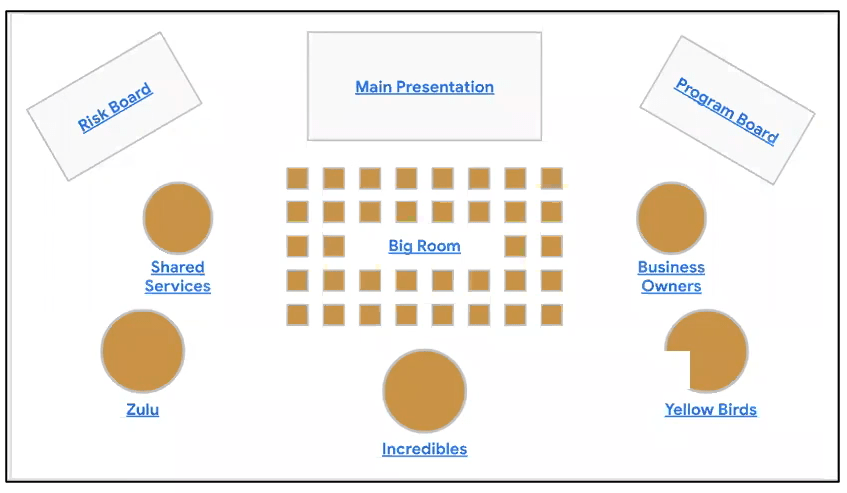Everything You Need to Know About Cprime Remote Services (Part 4)
Myths Busted and Questions Answered
In Parts One, Two, and Three of this four-part series, we discussed the reasons behind the rise in popularity of remote coaching and training programs, and the methods and tools our coaches and trainers have found to be successful. But, that left a lot of questions unanswered, especially in the minds of organizations forced to dive into remote work unexpectedly in recent weeks.
Part Four will address these questions and some commonly held misconceptions about remote coaching and training programs that may be holding some back. Let’s jump right in:
Tools for remote communication and collaboration
In Parts Two and Three, we went into detail about many of the tools our coaches and trainers have successfully used while engaging with our clients. Some of the most common include Slack, Zoom, Microsoft Teams, Confluence, and Jira Align. But, obviously, the list of tools that could potentially be used is much larger. And, all the available tools have their own strengths and weaknesses.
So, consider these questions and persistent myths:
____ is all we have. Will it work?
The answer is “maybe”, with a slight leaning toward “probably”.
You see, the bare minimum requirements for a given tool to be used effectively in a remote coaching or training situation are pretty basic, and most of the tools on the market are good enough to accomplish the purpose. Of course, systemic limitations — like the number of active users allowed or limited feature sets — can interfere under certain circumstances. But, those limitations are often a matter of subscription level and/or configuration as opposed to the tool itself being inadequate.
What’s more important than the specific platform being used is the commitment of those involved. If everyone is committed to making the most of the situation, and willing to follow some basic rules of engagement to make sure everyone knows how to make the best use of the tools available, the coach or trainer can generally adapt to a tool’s idiosyncrasies.
What about remote coding collaboration?
We spent most of our previous discussion focused on tools for communication and collaboration — both generic and agile-specific — but there are definitely cloud-based development tools that do an excellent job facilitating remote collaboration on coding projects as well.
Here’s a recent example where one of our trainers was running a remote dojo experience and participants were able to run through mob programming exercises using Visual Studio Live Share in a Zoom video conferencing breakout room.

Again, the tool itself is not as important as the willingness to make it work.
Myth: Teleconferencing is sufficient for remote coaching or training
In some cases, individual participants or even entire organizations decide they’d prefer to just listen in to remote coaching or training events. They want to call in but skip the video.
Of course, listening in is better than nothing. But, based on our experience, there’s not even a comparison between the value and efficacy of a session run over a video conference versus strictly audio. There are a few reasons for that:
- In most cases, the session has been prepared with some sort of visuals making up a significant portion of the instruction. So, if you’re listening to a presentation or demonstration in which the instructor is constantly referencing visual aids you can’t see, you’re going to miss a lot.
- Everyone learns in different ways — seeing, hearing, doing — and you may prefer auditory learning. But, there’s no denying that everyone learns better when taking in information in multiple ways. Video adds the visual dimension that’s not possible over the phone.
- Additionally, it’s easier to stay fully engaged when you have something to look at and listen to. Even with the best of intentions, if you’re trying to counteract the distractions of home with just an audio feed, you’ll have a tougher time.
- Finally, the instructors and fellow participants are all able to interact more effectively when they can see each other “face-to-face”. Since a huge part of communication is non-verbal, being able to see each other via the video conference enhances every interaction for everyone involved.
Remote coaching and training methods
These questions focus on how the remote training or coaching is delivered, rather than which tools are used. And, the same ideas can translate into how remote teams can continue handling certain types of work remotely after a coaching or training event is over.
How can our daily standup (or, any other meeting) evolve to virtual?
There are a number ways to adapt your existing standup process to work in a virtual setting, and there’s really no right or wrong way to go about it, as long as the whole team is still benefiting from the standup.
Here are some suggestions from coaches who have led virtual standups with clients in the past:
- The simplest method may be to set up a video conference with the team so everyone can see everyone else, just as you would standing together in front of a whiteboard. Then, using Zoom’s screen sharing function, bring up a simple electronic version of that board. Trello works well for recreating any Kanban-based board, and it’s a great tool for ongoing remote work that’s highly collaborative as well.
- For an added layer of accountability, which can be beneficial with newly remote teams, it’s a good idea to include a “by next” column on your Trello board. That’s where team members move cards they’re committing to completing “by next” standup.
- When involved in remote daily standups or other collaborative meetings, don’t be afraid to take a little more time than you may have in the office to just talk and interact. We take for granted the social and emotional benefits of being around our coworkers and colleagues every day. When that opportunity is gone, it’s important to be more intentional about recreating it whenever the opportunity arises.
For larger, more complex meeting arrangements, such as PI planning meetings, the same principles apply, albeit at a larger scale. The real difference is the amount of planning and forethought required on the part of the facilitator(s). One of our coaches offered the following example:
“This was a graphic I used to illustrate our virtual ‘room’ and the different ‘tables’ the whole team would have used if we’d been together at the office handling their PI planning meeting. Each link on the graphic was a separate breakout room on Zoom. So, we all got together on the video conference in the ‘Big Room’ to start things off, and for the main presentations, readouts, and things like that. But, when various people were supposed to be collaborating on certain things, they would just go to that breakout room and work together, then bring their results when we met back.”
The more complex the meeting, or the more crucial the outcome, the more important the planning beforehand. And, the more important the working agreements accepted by everyone involved. When planned well and executed effectively, there’s no in-person meeting that can’t be effectively recreated virtually.
Myth: Remote coaching or training is not as effective as in-person
This particularly enduring myth was well covered in Part One, but it bears repeating here:
In most circumstances, remote coaching and training sessions are not only just as effective as in-person events, they’re often more effective. This has as much to do with the inherent benefits of remote work in general as with the skill of the instructor and the quality of the tools being used. Remote workers tend to be more relaxed, more engaged, and more productive. Naturally then, with everything else being equal, remote employees participating in a coaching or training session will probably get more out of it than their in-house counterparts.
That being said, we’re not preaching that remote coaching or training is the optimal solution in every situation. In each case, our coaches and trainers will evaluate the specifics and help each client determine the best options for success.
Myth: Remote work goes against the Agile Manifesto
This myth is deeply rooted in the purest of agile thought patterns, and we certainly don’t want to downplay the intentions behind it. The fact is, the sixth of 12 Principles Behind the Agile Manifesto reads, “The most efficient and effective method of conveying information to and within a development team is face-to-face conversation.” But, it’s not a valid argument in 2020, and here’s why:
- The Agile Manifesto was signed in 2001, and it was specific to software development only. Think about how much less connected the world was in 2001 compared to the tools and capabilities that we have now. And, consider our current focus on complete business agility and what that requires in terms of evolving the Manifesto’s principles.
- Then, consider the fact that the twelfth Principle reads, “At regular intervals, the team reflects on how to become more effective, then tunes and adjusts its behavior accordingly.”
- It’s clear that the intent of the manifesto signers was to encourage developers to get out of their cubicles and start talking to each other. It’s about letting the work benefit from ongoing collaboration and continual improvement.
- So, it only makes sense to take full advantage of the tools and resources we have today to support the spirit of the Agile Manifesto rather than trying to force teams to follow the letter of the law.
Challenges from within your organization
As we’ve also noted previously, many of the challenges standing in the way of effective remote coaching and training opportunities can be traced back to cultural and process-related issues from within the client’s organization. Here is two common questions and one persistent myth that fall into this category:
What if leadership in my company is unwilling to spend money on new tools for remote work?
That’s a tough situation, no doubt. And, sadly, we do find that some of our clients and prospective clients are simply unwilling to budge when it comes down to investing in the tools required to make remote work possible. We have to imagine those organizations that adamantly refused to consider remote solutions prior to the appearance of COVID-19 are regretting that stand today, because most Americans are currently* under some level of mandated social distancing or stay-at-home orders. If their employees can’t effectively work from home, what’s happening to that company right now?
That all being said, it’s likely that every organization that survives the full impact of this situation and comes out the other side will be quick to embrace remote work going forward, if only as a necessary contingency plan. If you’ve requested investment in the necessary tools in the past and been turned down, try again.
*Article drafted April 5, 2020
Myth: Remote coaching or training is not worth the price
We have a feeling the companies perpetuating this rumor are the same companies addressed in the previous question.
As noted earlier and in previous posts in this series, remote coaching and training have proven to be highly effective opportunities for training and developing teams across numerous industries and disciplines. Remote teams are highly engaged and productive, and they value the opportunity to learn and grow with the flexibility of remote events.
Additionally, we highlighted in Part One that there are some real cost savings to be found in remote coaching and training options when compared to in-person events, especially related to travel. So, we’re confident saying that the price is potentially lower and the results are potentially better, removing all claims that remote coaching or training is not worth the price.
If you’d like to explore Cprime’s virtual coaching and training opportunities, click below. We look forward to discussing the options with you.



